« Chronique:BWU 23/07/2010 » : différence entre les versions
| Ligne 38 : | Ligne 38 : | ||
My triumphant return to the studio was heralded by the deafening sound of silence. Though a ton of work is being shoveled into the well-oiled test engine that powers the critical Release Candidate process, many of the regulars around this joint have been forced to relinquish their depot access and step far, far away from their builds. What was just recently a cacophonous hive of sweaty man children, swirling snack food wrappers, and a handful of very patient and professional women working extremely hard to squash every last bug they possibly could, has fast returned to a calm and dormant state. Plenty of people are now playing from home or at their desks and the community pod is so lonely I could cry, with Sketch already in the thick of it at this year's Comic-Con (speaking of sweaty man children). | My triumphant return to the studio was heralded by the deafening sound of silence. Though a ton of work is being shoveled into the well-oiled test engine that powers the critical Release Candidate process, many of the regulars around this joint have been forced to relinquish their depot access and step far, far away from their builds. What was just recently a cacophonous hive of sweaty man children, swirling snack food wrappers, and a handful of very patient and professional women working extremely hard to squash every last bug they possibly could, has fast returned to a calm and dormant state. Plenty of people are now playing from home or at their desks and the community pod is so lonely I could cry, with Sketch already in the thick of it at this year's Comic-Con (speaking of sweaty man children). | ||
[[Fichier:BWU Zombie Shishka Comic-con 2010.jpg| | [[Fichier:BWU Zombie Shishka Comic-con 2010.jpg|center]] | ||
<small><center>Zombie Shishka Thirsts For Braaaaains</small></center> | <small><center>Zombie Shishka Thirsts For Braaaaains</small></center> | ||
Version du 23 octobre 2021 à 15:49
Original
Posted by urk at 7/23/2010 2:42 PM PDT
So lemme get this straight. I take a short siesta for some sweet baby-makin' and Sketch and Luke blow the lid off of our entire stash of sweet Bungie.net treats? They revealed the return of an old favorite with our Rooster Toothed friends, showcased all the explosive day one Armory offerings, complete with not one, not two, but sixty-freakin' seven images? Unveiled achievements, put shiny medals on display, detailed a new armor ability, and capped it all off with insightful campaign details straight from campaign design superstar Chris Opdahl?
I was saving all that for later! How am I supposed to follow that up this week!?
With Forge World, Forge 2.0, and Firefight Versus details. You thought last week was our big salvo? Hang onto your helmets. (And get some balm ready for that forefinger. You got a lot of scrollin' to do, people.)
Feels good to finally show off what's outside the canyon and showcase the newfangled upgrades coming to Forge in Halo: Reach. You made a lot of noise about what you wanted out of our map editing tool, and as you can see, our designers, artists, and engineers were listening intently. We can't wait to see what you show us when you finally get your hands on it.
Since we're on the subject of show and tell, let's have another look at what's packed in with Halo: Reach, should you decide to go for the upgraded goods or replace your old, big, and busted Xbox 360 with the aesthetically amazing, artfully designed, ONI-inspired Halo: Reach Xbox 360 slim.
Bam! Remember when Sketch said that Halo: Reach was gonna be the biggest game of the year? Yeah, he wasn't kidding. Check out the sheer size of this monstrosity!*
Both videos embedded above, along with nearly forty new high resolutions screenshots are available right now on our Halo: Reach Project Page. Get 'em while they're hot.
Easy Mode
If all the digital pre-order and early bird options have your head spinning, I'll try to break it down for you nice and simple like.
- In North America, a day one purchase of any of the Halo: Reach editions will net you a code to download the Recon helmet permutation. Outside of the US, you'll have to pre-order.
- Pre-order at Gamestop and you'll also get a fancy, exclusive chest piece for your Spartan thrown in for good measure.
- Buy the Limited Edition and you'll get access to an Elite permutation for use in multiplayer, along with the aforementioned Spartan Recon helmet.
- Buy Legendary and you get Recon, the Elite, and the Flaming Helmet Armor Effect for use in multiplayer, plus Behind the Scenes Bonus Content to download and drool over.
We'll talk about the contents of the Behind the Scenes action a little bit later on. Like not this week later on. Rest assured, though, it'll be a tour de force.
For now, let's talk build status.
All Quiet on the Pacific Northwestern Front
My triumphant return to the studio was heralded by the deafening sound of silence. Though a ton of work is being shoveled into the well-oiled test engine that powers the critical Release Candidate process, many of the regulars around this joint have been forced to relinquish their depot access and step far, far away from their builds. What was just recently a cacophonous hive of sweaty man children, swirling snack food wrappers, and a handful of very patient and professional women working extremely hard to squash every last bug they possibly could, has fast returned to a calm and dormant state. Plenty of people are now playing from home or at their desks and the community pod is so lonely I could cry, with Sketch already in the thick of it at this year's Comic-Con (speaking of sweaty man children).
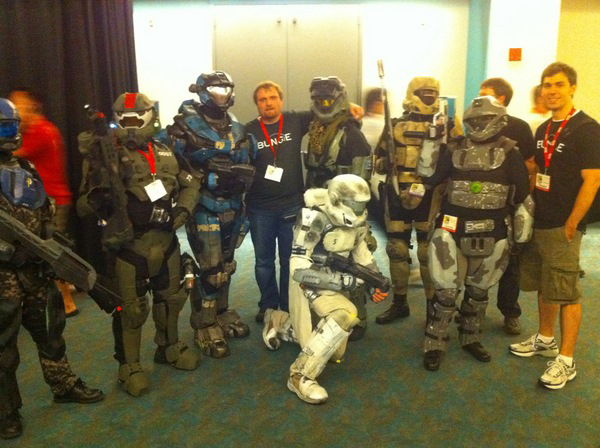
And speaking of playing from home, it looks like a couple of designers got a little too engrossed in their epic campaign runs this week. While that bodes well for the addictive nature of Reach's campaign, it created a small problem for Test, and when Jaime Evans couldn't get into contact with either man in the field, his seedy underling, David Gasca, took matters into his own hands. He did what anyone in his position would have done. He abused the crap out of our in game messaging tools.
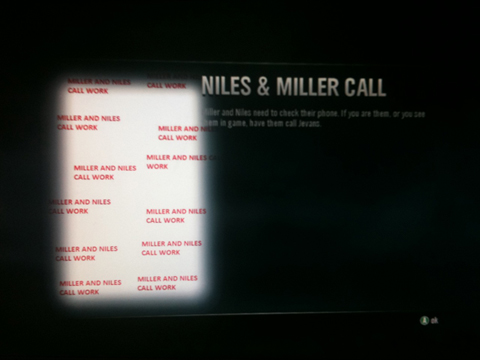
As Gasca and Jevans desperately attempted to wrangle a pair of designers, one lonely and likely overworked Test scribe took it upon himself to pen a hilarious, if not sobering, list of potential Release Candidate Achievements.
Domination – 50 points Pull a shift longer than Dom.
RC 1 Million – 25 points Break the RC.
I Can See Through Time! – 50 points 1000mg of Caffeine.
Midnight Munchies – 50 points Do a Burgermaster run.
Hygiene Not Optional – 50 points Own a functioning shower curtain.
COMMando – 10 points Crash every devkit in the studio simultaneously. (Yup, this happened.)
Who's Your Daddy? – 15 points Don't see your kids for three days.
Home Sweet Home – 10 points Physically force a person to go home.
Bungie's Biggest Gainer – 10 points Gain five pounds in one week day.
Cowboy – 5 points Change the file system during RC.
Scarab Jockey – 5 points Reactivate the same bug five times.
Schedule-Conflictamajaro! – 50 points Try to cut an RC on a night when there is scheduled PartnerNet downtime.
Harrison, Go Home! – 15 points Successfully kick Harrison out for the night.
Wrath of Gooch! – Negative 10 points Do anything.
Hopefully you find some humor in our Test team's pain. They suffer for you.
The Ballad of Forky
Ah, suffering. Let me tell you a tale, nay, sing you a song, of metal and rubber and a heart as big as the world. Let me hearken to you...the Ballard of Forky.
Forky was a fine steed, but more, he was a fine friend. From the moment my MJOLNIR-clad buttocks pressed deeply into his supple leather seat, I knew ours was a bond that could never be shipped to the wrong depot. And as we lifted boxes and crates together, my hands slipping perfectly around his ergonomic controls, truly it was my heart that soared.
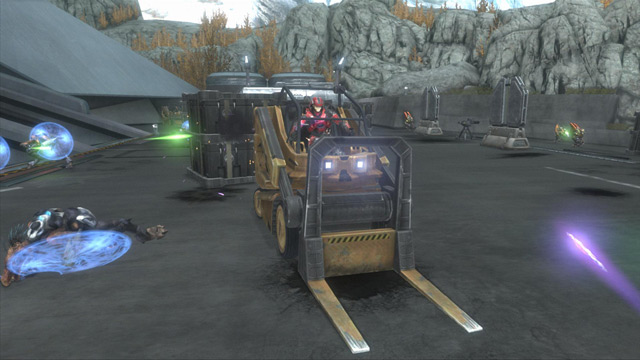
Together we were a force to be reckoned with. Even amidst the Covenant invasion, we refused to shirk our duty. We knew that each and every load could make all the difference. Undelivered, a Marine might go without his beans. A trooper, without her helmet. It was our duty...no, it was our passion.
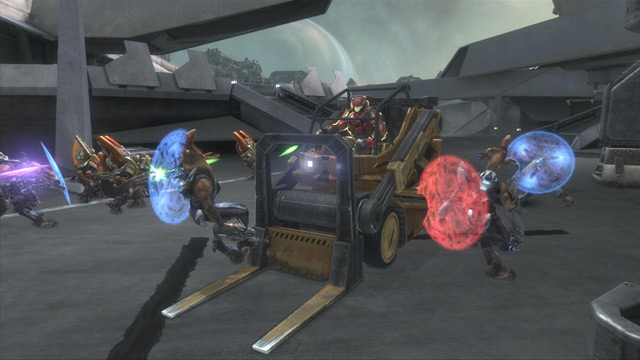
But it would not last forever. It could not last forever. I'll spare you the details, for to relay them now would be to tear my own soul asunder. To rend my heart into a million beating pieces.
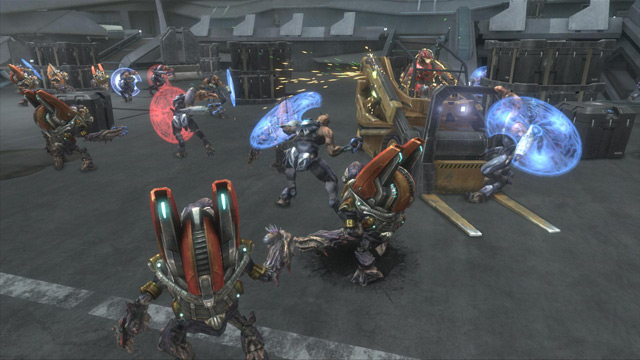
Forky was brave. He was heroic.
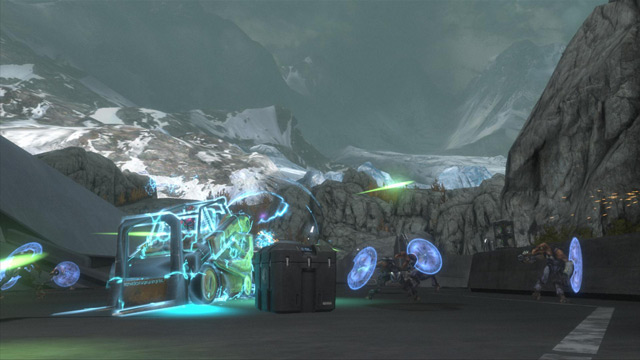
But in the end, even together, we could not push the Covenant aside. Our two-pronged assault was not enough. The odds were stacked against us.
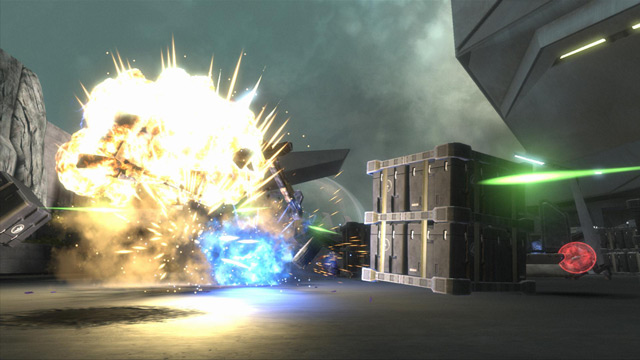
Rest in peace, dear Forky. I pray your soul will be lifted to some beautiful warehouse in the sky, where eagles soar defiantly above fields of pristine crates, each pining for safe transit and temperature controlled storage.
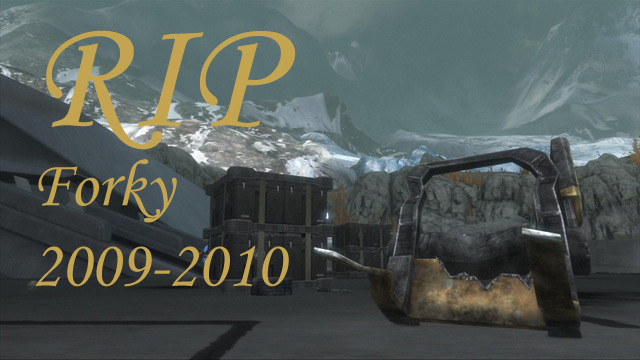
Godspeed, my hydraulically gifted friend. You will be missed.
Now, I know what you're thinking. Dear God, they cut the Forklift. I'm sorry, friends. Sometimes I want to have a little fun at your expense. The Forklift wasn't cut. It's alive and well along with a stable of other civilian vehicles, all idling warmly, waiting to go on an adventure with you.
A Whole New Forge World
So, what's outside the canyon?
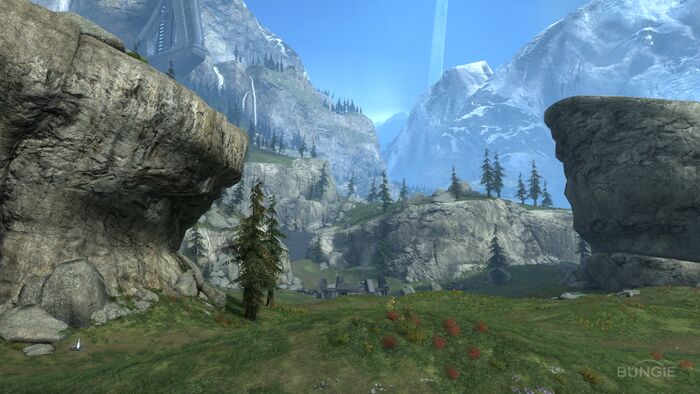
A whole new world, that's what. Forge World is massive. In fact, it's the single largest expanse of multiplayer real estate ever included in a Halo game (betcha haven't heard that before!). And it's seamless. If you're playing around on the cliff and see some poor, unsuspecting schmuck running around on Pinnacle far below, you can put a slug through his helmet from your lofty, far away perch.
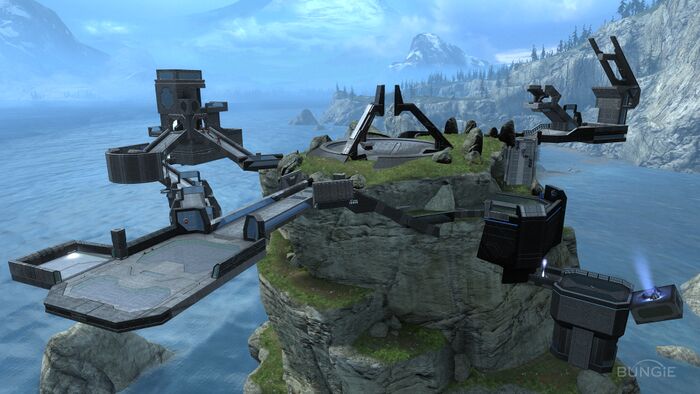
And of course, if you're looking for a more contained experience, you'll have complete control over the size of the playable space. Remember those "Return to the Battlefield" warnings you received when you slipped too far past the boundaries in the Beta? You'll be able to place (or remove) them with Forge. You can leave your playground wide open and allow players to explore the space, or you can confine them to a single base on Hemorrhage. It's ultimately your call.
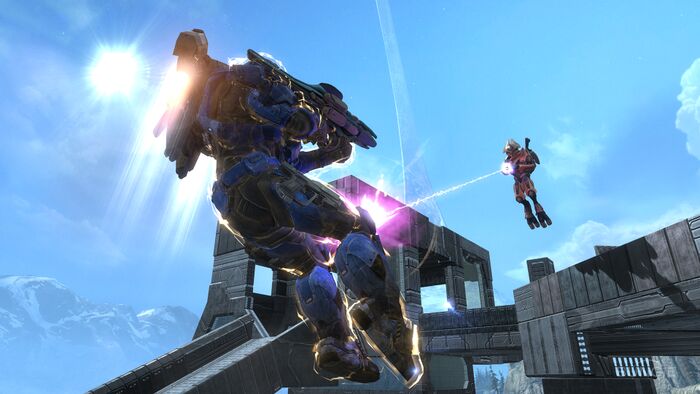
And that's just one of the shiny new levers you'll have at your fingertips. Overall, there are roughly 150 objects for you to tinker with, from building blocks to actual buildings, and that's still not even close to scratching the surface of the customization options you'll be given access to.
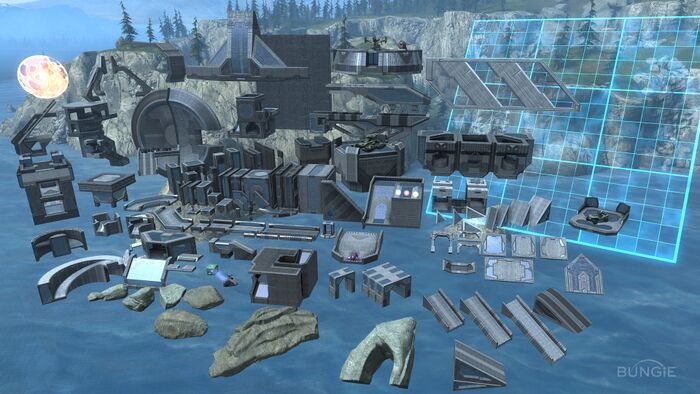
Global Rotation Snap for all objects?
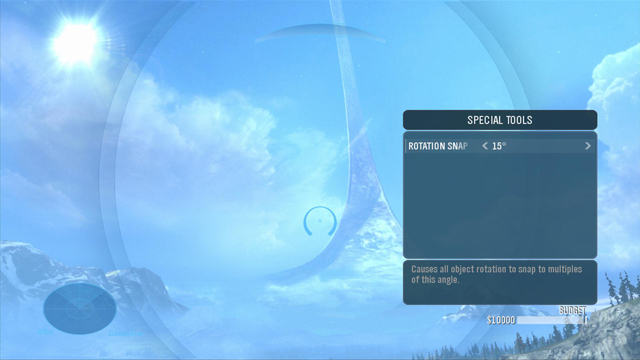
Rotation Snap, per object?
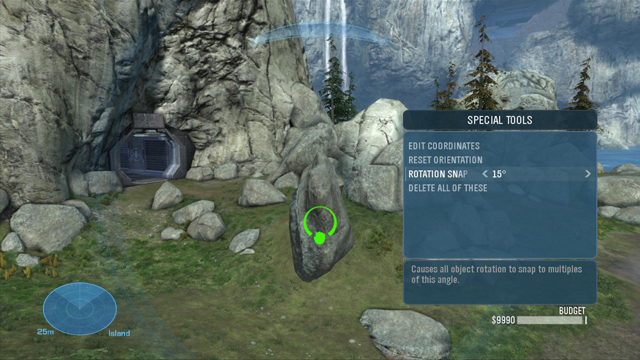
Maybe you'd like a sweet, glowing grid just like the one you're already familiar with from Sandbox, only you want to place it in a spot of your choosing so all of your placed objects float on a parallel plane.
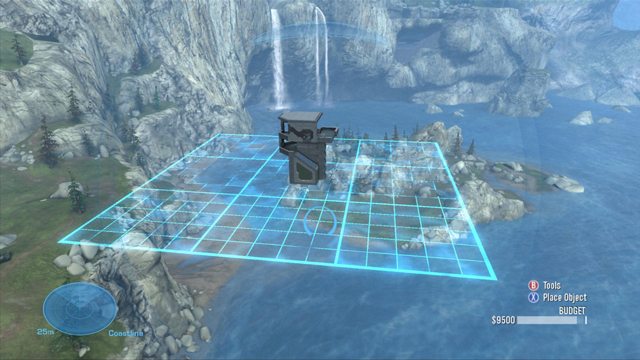
Phased object placement?
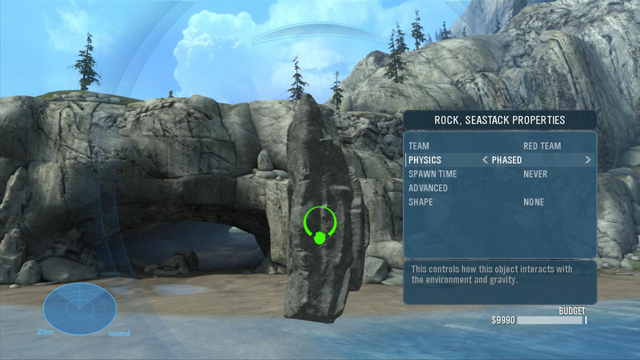
It's a bit difficult to get a sense of scale on that Sea Stack, so after I fiddled with phasing it into the ground, I thought I'd slap a Spartan on it and pull the camera back to help you size it up.
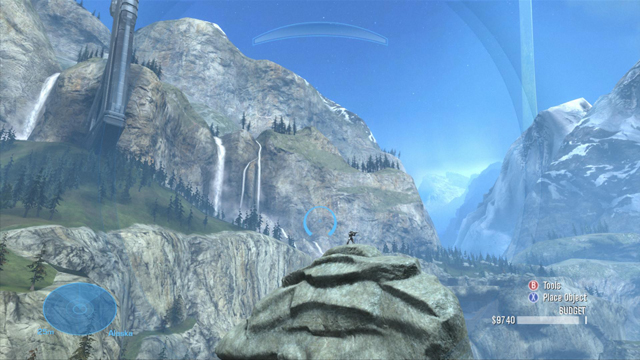
Maybe you want to nudge or rotate an object along the X, Y, or Z axis without using the sticks, but instead by adjusting the actual coordinates for ultra fine tuning down to one tenth of a world unit.
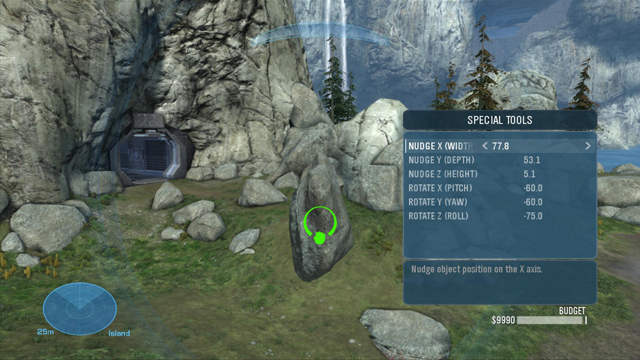
There really is an absurd level of layered customization built into Forge 2.0. To help you get your head around it a little bit better, here's what one of the Father's of Forge, Tyson Green, had to say about the latest iteration.
Forge-a-Saurus Rex
"When we added the Forge feature in Halo 3, we expected to tap a creative streak in our community. What we did not expect was the intensity. So determined was that streak to express itself that it burned through our naive offering, consuming it and finding new ways to use it.
So when we returned to the Forge in Reach, this was deeply impressed on us: don't fight that streak. Take the things that were hard and make them easy, and give authors more of what they need. Space, settings, objects, and better tools. Help the community express its interests and creativity, and let that be our fundamental goal.
You won't find Forge 2.0 to be an unexpected, unwelcome departure from what you know. But you should find it to be easier to build with, and richer than ever. We can't wait to see what you guys do with it."
And here's what he had to say during an impromptu question and answer session he conducted in the wake of the announcement on our forums:
| Posted by: DeftestAdam366
If the Bungie overlord comes back, is there a weather effect? i saw we had night effects but I'd love things like snow and rain |
|---|
No weather effects in the Forge. Was something we wanted, but something we didn't get to in time.
But, there are filters similar to the ones we introduced in Sandbox, a few of which do a pretty good job of making it look like night, late afternoon, and some other visual effects.
| Posted by: TOM T 117
Hmmm, what if the Warthog is destroyed? Does the hill remain in the wreckage (then move back to the vehicle upon respawn), disappear until the vehicle respawns or must vehicle-hills be indestructible for it to work? |
|---|
In the case of KotH, it'll move the Hill to the next object set up to be a Hill.
It really is more fun with indestructible vehicles, though. :)
| Posted by: freefall722
Can you offset the shape area from the object? Like make it float above it or to the side of it? |
|---|
You can offset it up or down (by setting the top and bottom heights appropriately), but not to the left/right. We figured you'd just move the object if you wanted to do that.
| Posted by: External Memory
BTW, are object maxes or global object limits returning? |
|---|
Yes, but they're quite a bit better now. A lot of objects are grouped together so that they share the same object limits ("inventory".) So if you're setting up a map and can place, say, 50 wall pieces, it's actually 50 wall pieces of any type, not "10 doors, 10 corners, 10 single-width, 10 double-width, etc"
The limits are pretty generous too. All of the maps we built are comfortably within the limits.
| Posted by: Blaster73
When you phase objects do they also stay fixed? Or do they only stay put if they a phased into another object? If the first is true then I am making a giant ball of phased objects suspended in air... |
|---|
A phased object stays where you put it.
| Posted by: everywhere116
Can you forge every gametype's objectives and spawns without changing through gametypes like in H3? Or do you still have to do that? |
|---|
You'll have to switch the gametype to set up objects for that gametype (e.g., choose KOTH to place KOTH Hills.)
It's not the most elegant solution, but we figure 90%+ of maps are set up for one gametype at most, so it ended up being the simplest overall solution.
| Posted by: wolfhunter9154
What about DLC? |
|---|
DLC? You mean "don't leak clues"? :)
Can't speak to what we have planned there. That's up to gentlemen like Sketch and Urk.
Nice try, kids. This ain't Tyson's first rodeo. – Urk
| Posted by: El Roboto
I wonder what would happen if you made a Warthog the Bomb and had to plant it at the enemies base. |
|---|
The Bomb (and Flag, and Oddballs) work a bit differently--you can control where they spawn, but not what actually spawns.
But, you could play Assault where the goal is to plant the bomb on a Warthog (or any other vehicle.) Or on a soccer ball!
| Posted by: vHyDroCiTy
Can somebody please answer this? |
|---|
There is not. :(
(Shocking fact herein revealed: we don't even have an Undo button on our internal tools! It's maddening! But it's also really complicated to bolt on at this point...)
Fortunately, object positioning is so, so so much better than H3 that it's usually pretty easy to get that object right back where you want it. Working with Rotation Constraints and Nudges makes it trivial most of the time.
| Posted by: BK Burger Boy
So say, if you built an objective gametype that utilized all 5 of the map segments, you would have enough budget to create extensive structures on each part withing the limits, or is the budget intended to be a lot more localized to one area? |
|---|
You wouldn't be able to build, say, Lockout in 3-4 places on the map. But you could certainly set up some Hemorrhage bases in a bunch of places on the map.
You can actually build quite a bit and pretty complicated structures pretty cheaply, so if you're imagining some grand battles across the entire length of the map, going from base to base, I'm pretty sure you could manage it.
| Posted by: the pib
Ferrex: I noticed in one video, when someone was spawning a Falcon, that the limit for Scorpions was 2. Normally that would be fine but Forge World is large enough that having even six tanks on the map would not be unreasonable. Is 2 Scorpions the absolute max, or were there already some on the map? |
|---|
There were some on the map already. The maximum number of Scorpions on Forge World is *checks map* 4.
| Posted by: Pokezilla Linked
Is that what it meant by "Basic Editing"? Is that the new term for "All Gametypes"? |
|---|
Yes, exactly. (I was hoping that question would come up in this thread, I've seen it a few times.)
Sorry, there is no corresponding "Advanced Editing" gametype. Basic Editing is already pretty Advanced. :)
| Posted by: Blaster73
How much inspiration for Forge 2.0 came from what users asked for and what they have created? |
|---|
A lot of it. Most of it. The Forge is 99% for the community, so we really took a good swing at building it "to spec", based on what the community was already doing with the Forge in H3.
| Posted by: Halo_Orlando
1.Are there visual or audio effects associated with the monitor? For example, does it do the light zinging noise when you move, and does it, as the picture shown in the update implies, give a little glow that extends from the monitor to the object carried? |
|---|
1. There's audio (flying sounds) and some little visual touches, but nothing on the objects he's editing.
2. There's lights, global screen filters, and a good selection of decorative objects. No explicit signs, I don't think (might depend on the map.)
3. If by interactive you mean destructible glass, afraid not. There are definitely destroyable objects, though.
4. Yep, you can set a teleporter to work on (and I'm pretty sure only-on) vehicles.
| Posted by: Yourm0md07c0m
so ferrex can you answer a question of mine? with a map that large it would take a long time to load right? so for maps that were made as sectioned off portions of forge world, will they have to load the entire map to be played? that seems like some firefight style load times to me. |
|---|
It loads as fast as any MP map. :)
(Load times mostly come from things like texture resources, and FF maps pay a large cost from the AI characters we have to load.)
| Posted by: Gaara444
Are giant interior rooms something you have to Forge? Or are they implemented into the map itself? |
|---|
There's one big interior space built into the map, and a couple of little tunnels on the Island.
| Posted by: FourKILLMASTER
I have some quick questions here. Has the player cap been increased and is there a tool that allows you to weld objects together? |
|---|
Player cap is 8 players in Forge (we pay some amount of networking overhead for the editing, so we can't have as many as normal MP), and sadly no, there's no tool for welding objects together (for technical reasons.)
| Posted by: freeglader
Why is there a dice? |
|---|
Why not?
| Posted by: wolfhunter9154
Also ferrex, Can we swim in the game? |
|---|
Deep water is as fatal to Spartans as spikes are to Megaman. :(
| Posted by: xXDarkCrimsonXx
Can kill zones be customized to be a one way door? Say if you enter the kill zone you cannot leave it. |
|---|
No, but we do have some one-way shield door objects that you could use to accomplish the same game mechanics.
| Posted by: Yourm0md07c0m
can you set it so that a gametype starts you with an armor ability and you can still swap them out? Ex: make it so you can only spawn with sprint, but you can pick up jetpack or armor lock elsewhere on the map. also is that annoying glitch (where you are holding something and you press y to delete it, but it deletes the object behind it instead) fixed? |
|---|
Yes, and yes.
| Posted by: Halo_Orlando
Interactive objects: Do they exist? Open-able doors, switches, glass? |
|---|
Afraid not. We ended up not using many of these at all on our maps, so we didn't spend a lot of time building them. Those that we did build were very map specific.
| Posted by: RTK ELUSIVE
will any of the built in forge world maps be used in matchmaking? and if they are how would barriers work as to not get to the rest of forge world during MM? |
|---|
Yep, you'll see these in Matchmaking. And the kill zones/safe zones are set up per map variant, so there's no fear of someone Warthog Jumping from one safe area to another.
| Posted by: Celticsgreen17
Is there a possibility to set rocket race checkpoints around the map? Where their first location is, then the 2nd after the first one is reached, etc. |
|---|
There sure is. :)
| Posted by: El Roboto
One other question: Is it possible to intersect objects with vehicles such as teleporters or blocks using the Phased option and still have them be drivable? |
|---|
Afraid not. The phased objects would remain fixed in their location, and the vehicles would push themselves out of the fixed object.
| Posted by: BK Burger Boy
How many Falcons can we have on the Map? |
|---|
The answer is 8.
(And I'm going to skip object count questions from here, otherwise you guys'll have me listing out the entire palette. :)
| Posted by: Jesse James 013
When merging two objects together by phasing them, do they blend naturally now, or do they produce flicker on the surfaces? Or is it dependent on technique, such as snapping to the grid or placing with slightly varying angles? |
|---|
They blend BETTER, but it still depends on your technique. A lot of the objects are designed to be snug up against each other, and that's the best way to avoid the z-fighting (the term for that flicker.)
| Posted by: Fishie1
Is there still the Forge hosting bug where the placed objects look different to different players in the game? Example: Player 1 perfectly arranges a row of blocks, but to Player 2 the blocks looked all skewed and misaligned. |
|---|
No, that one should be fixed now. That was one in particular that we wanted to crush.
| Posted by: Darth Nader 08
ferrex, what does the object color mean? I know about the team color, which is complete and utter epicness, but the second option gives me the heebie-jeebies. |
|---|
It's really just setting a specific color for the object instead of using the team color.
| Posted by: CQB shotgunner
Ferrex, if you are allowed to tell us, what was the hardest part of building Forge 2.0? What was the most enjoyable part? |
|---|
The hardest part was [getting] it down to something we could finish, polish, and ship. That's always the hardest part, cause you know that every one of those little features would've BEEN SO COOOL! But that's how the process works.
The most enjoyable part was seeing folks like Shish building real, new maps. And, of course, working on my own ports of old favorites. :)
Tyson tells me he's thinking about revisiting some of his old turf. – Urk
| Posted by: Time Glitch
We already know we can spawn objects at a certain point in time: "Respawn Time" and then set "Set at Start" to "No". Can we now get objects to go away after a certain point? |
|---|
Afraid not. Other than garbage collection, the engine doesn't have any concept of "despawn time", and it never came up as something we really wanted. I can see how it'd be useful, though... dang. Got me there. :(
| Posted by: Insane AlphaBeta
i got a question [as does everyone else] but still when you first go in Forge World is it completely blank with nothing on it? or do you have to delete everything? |
|---|
I think we're shipping a blank version on disc this time.
Yup! The Forge World map listed in the default selection menu is indeed a blank canvas. – Urk
| Posted by: ShiningArmor16
With forge 2.0 will it be possible to create gametypes where all players have the same super weapons (eg: flamethrower or fuel rod gun) which wasn't possible in Halo 3? Thanks! |
|---|
More of a game options question, but yeah, you can start everyone with any weapon in the game.
| Posted by: Blaster73
Can every single object be set as normal, fixed, and phased? For example in Halo 3 certain things like pallets, explosives, spawn points, guns, and vehicles would never stay fixed. |
|---|
Not everything can be fixed. Vehicles, for example, will always be physical.
And it looks like Jon is shaking his fist at me right now. Hmm.
| Posted by: the pib
Can we "dig" by creating empty space inside solid rock? It would be great to be able to excavate a cave in a rock wall, build an underground vehicle bay or bunker, or have a tunnel running under a field. |
|---|
Afraid not. Forge is a humble object editor, not quite capable of full on terrain editing of that sort.
You could pile up a bunch of rocks and then delete the ones in the middle, though!
| Posted by: MartinOfRedwall
What system does forge use to give you credits after you're done forging? |
|---|
Time actively spent in the Forge does provide some credits.
(And pre-emptive chill-out: we do distinguish between "active", "idle", and "rubber band on your controller". ;)
| Posted by: Bionic Juice
Are all weapons available on all maps? I know in H3 some weapons wouldn't show sometimes. |
|---|
All weapons, all maps. The MP guys had strong sauce this time, and budgeted accordingly.
| Posted by: Archangel755
I must know Ferrix, if you'd be so kind to respond to this. Is there water that is deep, but not deep enough to kill you on Forgeworld? So, water that you can walk around in, and not die. And if so, how much of the water can we walk in? Thanks. :) |
|---|
Yep, there's shallow water. I had some fun early on setting up a Race map which send you driving along the beach beside and around the Island, a lot of which has you swimming and fording shallow water.
| Posted by: Scarphace
Ferrex, Forge World seems a little big even for an 8 vs 8 Team Slayer game. I don't want to spend ten minutes wandering lonely caves and bases alone, with not even a blip on my radar. How has this been addressed? |
|---|
Safe Zones limit players to certain parts of the map, as defined by the map author. If you leave the Safe Zone, you either die (hard Safe Zone) or are warned to return to the battle (soft Safe Zone.)
| Posted by: critical ghost1
Can trees be forged Also how many items total can we place at one time |
|---|
I don't think there's any trees. They're just not very good objects for this kind of use--very floppy, physical, and hard to pull off believably.
And number of objects depends on the objects you choose. It'll vary a lot.
Nope, no trees. It was considered, but ultimately wasn't worth removing something else in its stead. – Urk
| Posted by: the pib
About placing AA's on the map... when you pick one up, does it disappear from the map and go into your armor, as if you're picking up a weapon? If so, is it possible to place an AA on the map that stays on the map after someone picks it up (so your whole team can all get Jetpacks from one object placed on the map) or is it necessary to place multiple of them on the map to achieve this? And what happens to your old AA when you pick up a new one... does it drop on the floor for someone else to take, or just disappear? |
|---|
It's like swapping weapons, so the old one hangs around.
| Posted by: Jesse James 013
Any chance that one of the objects is a GIGANTIC wall, so we no longer have to build walls out of smaller blocks? |
|---|
There is, in fact, a gigantic wall object. It's pretty damn large.
| Posted by: Time Glitch
Can we still make objects be affected by gravity lifts and what not? This is pretty much how we made opening and closing doors beforehand, and I didn't see any objects like Crates or Dumpsters in the ViDoc. Can we still do those kinds of things? |
|---|
Yep, those sorts of objects still exist.
| Posted by: BLOODED 2951
Ferrex, Can kill balls be expanded to make a lava pit? Also, will man cannons possible negate fall damage? |
|---|
No, but you could make a lethal fall by using a kill zone.
And I'm pretty sure man cannons can't negate fall damage. User beware!
| Posted by: Yourm0md07c0m
when you set a vehicle to be team specific, does that mean that only that team can drive/pilot it? |
|---|
No, I don't think vehicles pay attention to which team owns them, except for inheriting team colors (in the case of the Mongoose on Rocket Race.)
| Posted by: The Pudie
Sorry if this has been said before. But how high can you fly/build items, is there a limit or can we build in the middle of the sky? |
|---|
Pretty dang high. There's lots of room for this kind of stuff.
Big thanks for Tyson for making room for this kind of stuff. But he's not the only one answering hard-hitting questions. Here are designers Steve "Yeah, he made your favorite map" Cotton, Christopher "P" Carney and Chad "Came From Behind" Armstrong to tell you all about the origins of the spectacular space that is Forge World.
Q. Where did the crazy idea for Forge World come from in the first place?
Cotton : When I was ten, I dreamed of a place big enough to make the world's largest Halo maps. This was odd since Halo had yet to be invented, but I guess in my own little world of G.I. Joe and Bon Jovi, I was a visionary. Sometimes I wish I had thought of different things instead…Google, Facebook, Megan Fox…but Forge World was my destiny, I guess. It's hard to believe Chris and Chad had similar visions at ten, but it's true.
Chad: At first, we had this plan to basically remake Sandbox in a new setting. We had a pretty straightforward plan for a setting in New Alexandria that would have met the minimum requirements for a map dedicated to Forge. But when we really started looking at Forge the tool we realized that a Sandbox remake would really have just been the minimum requirements for a Forge map. We were capable of much more! So, we scrapped that in favor of a new plan. With the ability to set an object to have "phased" physics, actual, fun-to-play terrain became non-issue. On top of that, we had these great spaces that could be repurposed for Forge. On top of THAT, well… How could we ship a Halo without a canyon to romp around in with your friends?
Q. Early on, I was looking at descriptions for several maps set on a Halo ring, each with a distinct geographical framework. Then, all of the sudden, it was all crammed into one massive World. What happened?
Carney: We wanted to make more competitive multiplayer maps for ship but only had art time to do one skybox. In addition, Eamondo and Cable had "green lit" our ability to fix and phase objects in Forge 2.0. So suddenly, rolling terrain was an achievable Forge canvas. If we could easily phase objects into terrain and fix them in specific locations, we did not need to create a flat orthogonal world (our original Reach Forge map was going to be human skyscraper under construction). So armed with the ability to do compelling things with terrain, we turned our sights to things more familiar. We came up with the idea of creating 5 terrain types (a rock spire, a cliff, a gulch, a small canyon, and a room) based on some of our favorite acreage and then intended to blend these together under one sky. Mr. Cotton took over from there with the intent of combining these terrains into one world (and one sky) which we would then eventually separate into 5 different Forge environments for ship. Chad and I then set to work on designing the pieces.
The pieces were based on several types of parts that we had used over the years (the main tower in Ascension = the invis tower in Zanzibar = "tower, 2 story" in Forge 2.0) as well as a series of "lego blocks" straight from the mind of Chad. These pieces were all strictly built on a grid in order to make everything line up nicely in Forge. Also, some of these pieces were designed to function even better when rotated or flipped.
Meanwhile, Steve struggled to carve the map up into 5 environments. "There can be only one!" he would scream when anyone approached his desk…
Chad: Cotton happened.
The plan for Forge World was that we were going to provide multiple spaces that were unique in terms of design but similar in terms of aesthetic. If a player wanted to make a canyon variant they'd pick the canyon map. If a player wanted to work in a smaller space, they could load the quarry. If a player wanted to work in a simple Sandbox Crypt-style box, there was the Coliseum. By working in the same aesthetic (Forerunner, in this case) we could reuse the same family of Forge objects across all of the maps and spare the art team the time to build specialized versions of all the pieces we were making for Forge. It was also a time saver on the maps themselves to use the same environment style, which really helped us sell the maps to our fearless leaders, who needed to be convinced we could actually complete the task in time to ship the game.
Because we were placing the maps in the same environment, it was decided that each map would be "hinted" at in the sky of the other maps. For example, looking down the cliff side from the quarry you'd see a valley that looked suspiciously like the gulch, and off in the distance that island looks like the island map, and so on. We considered that fans would probably gripe that they wanted to just be able to fly between all the maps, but hey it wouldn't be difficult to explain how that wasn't possible, right?
Meanwhile, Cotton had a master version of Forge World that allowed him to work on all of the spaces at once. At first this was just to make the task of working on the map easier for him. But when he realized it wasn't a total disaster when he compiled the entire map (that is to say, performance wasn't destroyed, lightmaps didn't look like dog vomit, and it was really, really, really cool) he pitched the idea to keep the spaces united to the rest of us. And then when people said no, I'm pretty sure he did it anyway. I'm pretty sure a dozen different people told him not to do even think about it, but Cotton will do as Cotton does.
Q. Why set this sucker on a Halo ring?
Carney: Halo contains amazing terrain. Plus our piece set was based on traditional (and non-traditional) Forerunner architecture. There really was no question as to where to set it.
Cotton: The truth. For something this big, we needed an aesthetic that was simple, refreshing, and versatile. Nothing compares in that regard to Halo.
Chad: Reach's feature set is expanded tremendously over the previous Halo games, but there are still limitations we must abide by. The limitations that affect Forge the most revolve around two issues: Lighting and Performance. To get the most out of Forge we had to build a palette of objects that were individually fairly neutral in terms of contrast and fairly simple in terms of polycount. The Forerunner aesthetic, with its simple angles and steely blue-grays was a perfect choice. Further, after so many games with Forerunner architecture, it's a lot less jarring to see large metal pieces jutting out of a rock face when it looks properly Forerunner.
Q. I read that all of the multiplayer maps were ripped straight out of the campaign. Does this mean that we're going to visit a Halo ring in Reach's campaign? (SPOILERS!)
Carney: Sure, buddy.
Cotton: Um…no. In a lot of ways you should think of Forge World as a unique experience. Not just because it's the only non-campaign related multiplayer experience, but because it's really like 100 levels in 1. There's a good chance that there will be more levels played in Forge World than all of the Halo's combined. Except this Halo, of course. That would be impossible.
Chad: While it was true at the time when we said our multiplayer maps were integrated with campaign, that changed when we started on Forge World. Noble Team will not be fighting their way through Blood Gulch, I'm sorry to say!
Q. Tell me of The Cage.
Cotton: The Cage is a Carney box. It's like Lockout on steroids.
Carney: The Cage was the original name for Lockout back when it was a Halo: CE map. It, of course, did not make it to the limelight till Halo 2, but also changed significantly over development. The latest version of The Cage is based on some of those pre-Lockout ideas and started on that Forge skyscraper (we named it "Blockout" since we are intensely creative people). Eventually it moved to Forge World. It is roughly the same scale as Lockout and is built around an open center, but features longer sight lines and paths that are strictly one way (unless you have a jet pack). Team Slayer (4 v 4) and SWAT feel good.
BTW, Pete Parsons named "Forge World." He too is intensely creative for a marketing guy.
Chad: The Cage came to be because we wanted at least one "built from scratch" map made to demonstrate that it could be done. It may or may not have helped that Carney promised to build a map from scratch in Forge and Derek and I taunted him into doing that. Wait, who said that? You can't prove anything…
Anyway, The Cage is an excellent slayer map, with a flavor not dissimilar from the Lockouts and Guardians of the world (while still being distinctly The Cage). In some VIP testing we did some time back, an earlier iteration was quite popular with a group of damn good Halo players we brought in to take a look. The map has changed a bit since then, but I bet they'll still like it.
Q. How faithful are the Ascension and Blood Gulch remakes? Are they pixel perfect remakes or spiritual successors?
Cotton: They're faithful to each other. Blood Gulch might have a little action on the side but otherwise they're pretty faithful. That's literally, not metaphorically speaking.
Chad: I wouldn't call Pinnacle either pixel perfect or a spiritual successor. The goal from the beginning was to build in Forge a map that matched (as accurately as it could) the structure of Ascension. In fact, the majority of the pieces used on the map (most notably the towers) were yanked out of Ascension and then tweaked to fit to Reach's scale and what we call the "grid;" fitting the objects to a standard unit of measurement that makes it easier to make the pieces fit together.
Hemorrhage is a hybrid of Blood Gulch and Coagulation. The terrain of the canyon is rezzed up from Coagulation, and the placement of natural cover and weapons is based on Coag's set up. The bases, however, are primarily Blood Gulch's one story bunkers with some Coagulation touches in terms of the structures providing cover on the rooftops.
Carney: Both Ascension and Blood Gulch needed some love (the originals are not perfect), but these versions are pretty damn close. Plus, if you don't like it, you can always go into Forge and fix it.
Q. So, Forge 2.0 is pretty cool then, eh?
Carney: It's not bad.
Chad: I think he's a pretty cool guy. He makes maps and doesn't afraid of anything.
For the sake of the ViDoc I went into Halo 3 Forge so Jim and his crew could capture an example of placing two overlapping pieces in Sandbox. The difference from Forge 2.0 is almost tangible. I'm not just talking about the difference in the number of steps to achieve the same goal, either. Everything you do as the monitor in Forge 2.0 just feels better than it did before. I spent an entire day building maps for brief film clips and had a great time, yet all it took was five minutes in the old Forge before I was filled with rage and asking questions like "How did I deal with this before without flipping tables and throwing chairs?" Then I realized that some of the things I did in two hours in Reach would have taken exponentially longer in Halo 3. Reach's Forge is simply awesome.
Cotton: Imagine if you took all the acorns in the world. And put them into a big pile. I mean, a HUGE mountain pile. A squirrel walks by and is like, holy s@% that is Forge 2.0! Now imagine you're the squirrel, in case that wasn't obvious. That's how it feels when you first load it up. Everyone should try it. Split-screen with a friend is even better! It's the most seamless, user friendly chance to do something that most people never get to do – to CREATE in a virtual world! Yeah, it's possible to make an awesome Halo map. But you'll forget about that as soon as you start building because you're already playing, you've been consumed by the size, and your mind starts racing through the possibilities, it's overwhelming and you forget why you came here in the first place. 2 hours go by and you've built a bridge to nowhere, a floating tower made of man-cannons, and a castle with turrets and a moat. That's when you realize you haven't even scratched the surface.
Q. What are some of the most significant upgrades?
Cotton: Controls are improved…um, actually good. I like to think of it this way. Forge 1.0 was like the first plane the Wright brothers built, you know, got the point across, but you probably wouldn't get in it with a gun to your head. Forge 2.0 is like the second plane the Wright brothers built…if their name was General Dynamics and it was an F-16! More, better, bigger. Pick an area, that applies.
Carney: Ask Chad. I struggled with Halo 3 Forge and did not use it much. One thing to note, since Chad and I were going to make shipping variants with the tools, we made sure that the Reach 2.0 tools were good and useful.
Chad: The camera changes are notable. The big difference is in what the movement is based around. In Halo 3, held objects move around the player, so as the player turns, the object is dragged along to keep with his reticule. In Reach, however, a held object is the point of orbit for the player. While holding an object, the player orbits around it when they move their look stick, moving themselves rather than the object, which would allows the player to grasp where their object exists in relation to the rest of the map without knocking things over or bumping the object into other pieces or world geometry. Another handy feature is that, so long as you're not rotating the object, when you grab something your reticule stays relative to where you grabbed. So, if you're trying to line up to bridge pieces, you can grab the end of one piece to line it up with the other, which is much easier than having to work from the center of the object.
The biggest change of course is the ability to set pieces to be phased which allows you to pass them through other objects and world geometry. That takes about 75% of the time Halo 3 forge authors spent working and setting it free right there! Plus with controls that allow for fine tuning such as the ability to make minute movements by holding down on the left stick, or by directly editing the coordinates of the object.
Q. What were some of the key issues that have been addressed moving from the old and busted Forge to the new and improved Forge 2.0?
Carney: That's a great question. Seriously.
Cotton: Chad's department. In my opinion, the MOST important new thing by far is phasing – the ability to push objects into the environment. This makes a lot of the cool new stuff even possible. Embedding bases into the ground, bridging gaps, and generally just building on the ground. Think of it more like constructing than just placing crates. After that, it would be the Rotational snapping – the ability to choose an increment to snap by when rotating (1, 5, 15, 30, 45, 90 degrees). You can also move pieces by small set increments to line things up easier. These, together, allow even a brand new player to build the cool new stuff really FAST. There are lots of other things that affect the experience but I won't ruin the surprise.
Chad: The ultimate goal we had while working on Forge 2.0 was taking the common "tricks" used in Halo 3's Forge and make them not be tricks, but standard features of the tool. A user's time in Forge should be spent building and testing the map, not going through a multi-stage process just to complete some basic construction. Building things well is no longer a trial in and of itself, allowing users to focus on making sweet content, and have fun while doing it.
Q. Where are my pants?
Chad: Not a day goes by that I don't ask myself that same question at least twice.
Cotton: DLC.
Carney: What are pants again?
Mapmaker, Mapmaker
If all this lip service about the fine art of Forging is sailing right over your head and all you care about is playing some sweet maps without having to do any work whatsoever, we've got you set up, too. We're not ready to blow all the new multiplayer spaces out yet, but here's the list of Forge World real estate we're definitely shipping on the disk:
- Hemorrhage – Many call this curious gorge their grave, but early inhabitants left only these outposts behind in memoriam. 8-16 players.
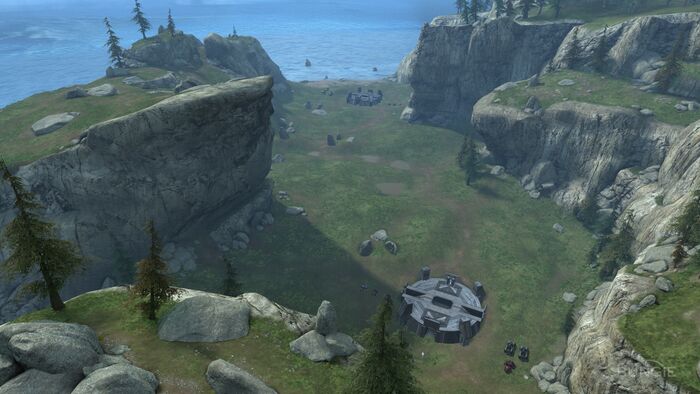
- Pinnacle – Even untold centuries of abandonment and neglect failed to stall the smooth operation of this ancient structure. 2-8 players.
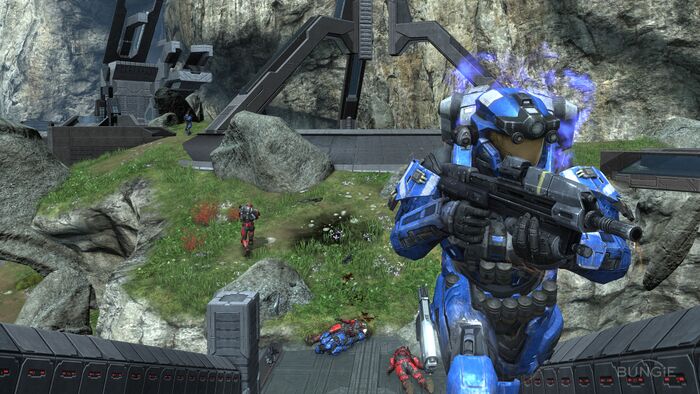
- The Cage – The walls are in your heart. 2.8 players.
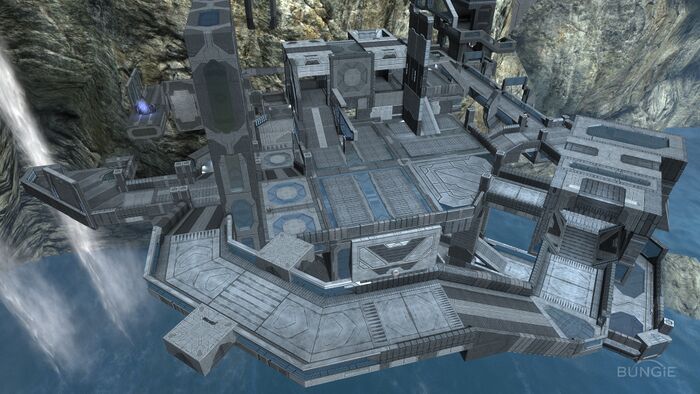
All three of these maps are ready to go without any additional manipulation. We've lovingly placed spawns, weapons, and taken them through the playtest paces to ensure that you'll have yourself a grand old time on them with minimal investment. And just like the Hemorrhage, they are merely the tip of the sea stack. We'll have more maps of our own and as Tyson alluded to above, we'll be on the lookout for hot new community content soon after launch. Alongside Forge, your ability to share content with other players has also been given a much needed boost (as have our own internal tools for taking and evaluating map submissions for inclusion in matchmaking).
Without making any brave new promises about the state of user created content in the not so distant future, I can say without question that we'll be intently seeking expertly crafted offerings from the multitude of Forge aficionados out there. We were shocked at the length people would go to work around the tools to build something great in Halo 3. We can only imagine what we'll get this time out.
Make us proud.
Kill Your Friends
There's an old adage around these parts. It goes. "Kill your enemies. Kill your friend's enemies. Kill your friends." So when the team regrouped in the wake of Halo 3: ODST to talk about what kind of improvements they could bring to the table for Firefight, one feature seemed custom fit to bolster the already intense invasion simulatin' experience.
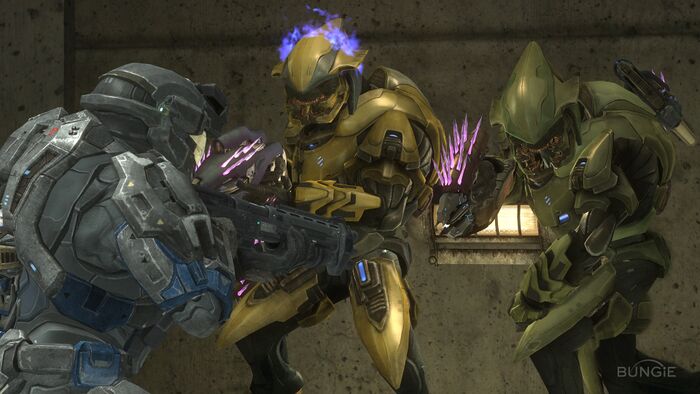
We call it Firefight Versus, and to explain it in a little more depth and detail, we've bribed and cajoled the one, the only LarsyB into talking about the bigger, better, and more bad ass version of Firefight you'll find in Halo: Reach come September.
Here's what he had to say for himself (and for Firefight Versus Mode):
When Paul, Tyson, and myself sat down to figure out how to improve Firefight in Reach, there were the obvious things like adding Matchmaking support. That wasn't enough, however, and we wanted to push it in terms of customization so we blew the doors off the Game Options. That still wasn't enough, and we wanted to try something different. We already know what it feels like to play as a Spartan surrounded by your UNSC buddies in the Campaign, but what does it feel like to be on the other side? Sure, we saw that in Halo 2 in the Arbiter storyline, but what does it feel like to be in a knock-down, drag out fight against your friends?
That, amigos, is where Versus comes in.
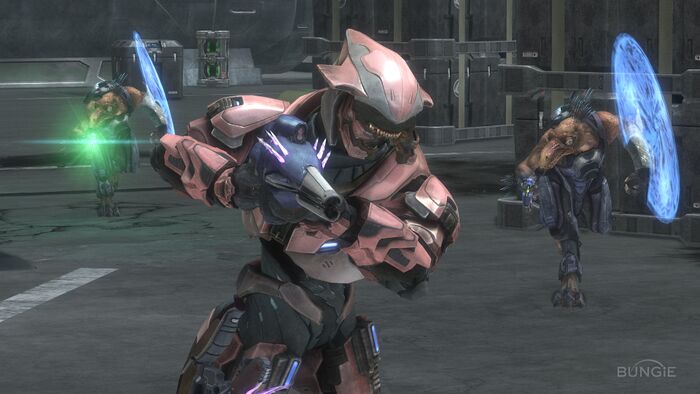
From the Firefight Lobby, with the press of a Bumper, you now have the ability to choose whether you are on the Red Team or the Blue Team. Red Team always starts as Spartans and Blue Team always starts as Elites. Like everything in Reach Firefight, Versus really comes to life with a simple little Option called "Turn Count." Once the limits are reached for the current Firefight session (can be time limit, lives, waves, etc), we swap sides.
So, the short version is if your Turn Count is set to One Each (can also be None, Two Each, and Three Each), when the game naturally ends we change sides and you play from the other perspective. After your turns are over, we end the game.
Wait, WHA? Yes, that's right you get to play as an Elite running around with all the Covenant at your side tearing apart the Spartans.
How does it work? Simple, whichever team has the most points after the game ends, wins. It's the classic Red vs. Blue you've always known and loved.
But how do you keep this fair? First off, you get to play from both sides which makes it pretty equal, barring player skill. Second, and more importantly, you can only earn points while on the Spartan team, so it makes both sides have a purpose.
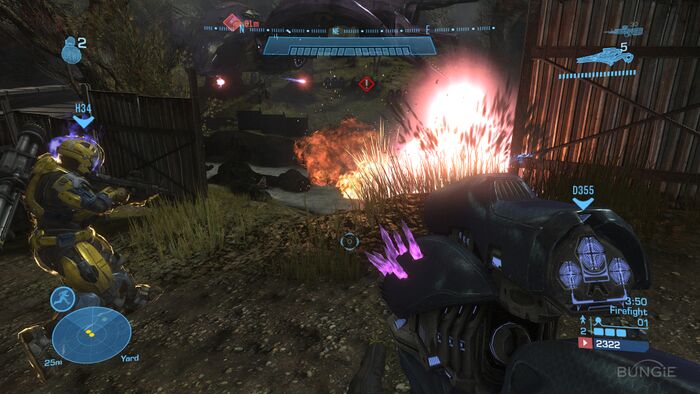
Ok, ok, I think I get it, but explain the finer details. What's my job as an Elite? Well, as the Elites your task is to stop the Spartans from scoring points by any means necessary. You have unlimited lives, but a longer respawn time. The other crucial piece of information is that if you die as an Elite, you are giving the Spartans an extra life as well as a big point drop... so be careful. If you continually throw your body into the fray, it will be very difficult to make up that point margin when you switch sides. As an Elite player you also have access to the number of Spartan Lives remaining in your HUD, so pay close attention to that number. It helps you know when you have them on the ropes.
So, what about Spartans, how does Versus change for them? The Spartans start by sharing 4 lives for their team and cannot have more than 4 backup lives. They have 5 minutes to try to score as many points as possible. Crucially, by default Elites do not make up any of the waves. So, when you see an Elite, you know that's a human player, or maybe it's a hologram of that human player. Gah!
Sweet! So, say I am way better than my other friends and I want to take them on by myself in Versus. Can I do that? Yup. You can set up the teams however you want. It can be 2v2 or 3v1. It's however you want to handle it in the Lobby.
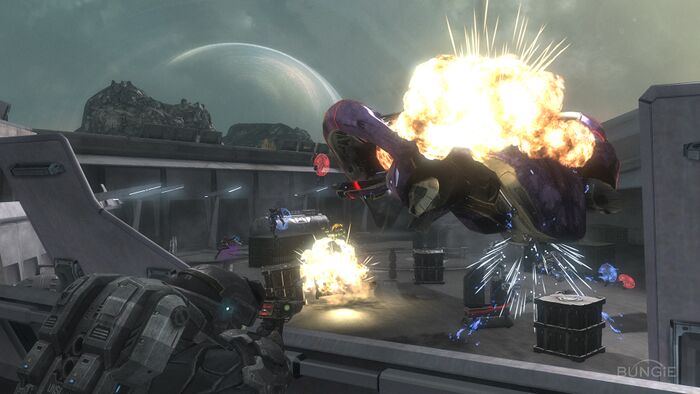
So, we know that Spartans have full Player Trait and Loadouts customization; does that mean Elites have that as well? Yes, the Elites have all the same Player Trait and Loadout customization as the Spartans but in their own category. Want to give the Elites Loadouts all Fuel Rod Guns with Jetpack? You can do that.
How does this work with the Custom Skulls? Can Elites be affected by them the same way Spartans are? Yes, of course! Custom Skulls are made up of Spartan Traits, Elite Traits, and Wave Traits. When we first showed off Custom Skulls, we just hid the Elite stuff in the E3 build so as not to spoil the surprise.
Hope you all enjoy Versus, it really is a new way to play Firefight. See you online on the 14th!
No, Lars. I'll see YOU online. (Why aren't you accepting my friend requests? It's me, the Jurkstore!)
Along with Versus, our Comic-Con contingent also took it upon themselves to reveal two new Firefight spaces, Courtyard (yes, there are Jackals) and the return of Overlook (previously known as Overlook).
- Courtyard – Wage war in a Courtyard outside an ONI building on Reach. Walkways, connecting rooms and plenty of cover make this a frantic space to fight in. It may not prove to be an effective weapon but feel free to jump behind the wheel of a Forklift if you feel inclined.
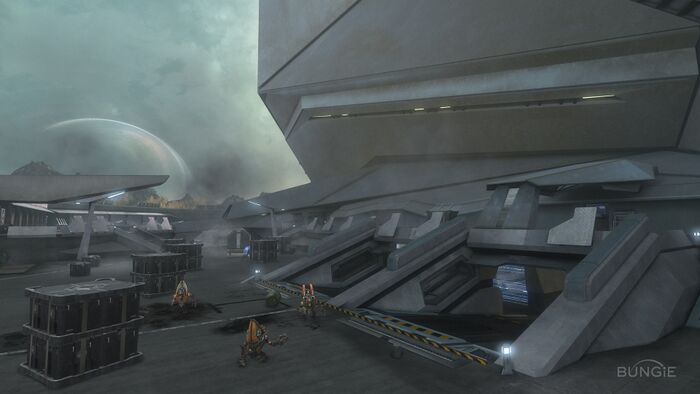
- Overlook – Fight against the Covenant in this settler dwelling set amidst the rugged Reach countryside. Take advantage of turret emplacements to hold off the Covenant crossing the river but beware the occasional Wraith.
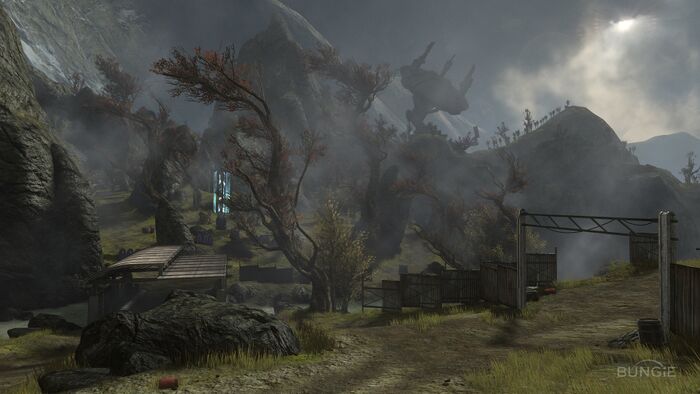
Mmm…Firefighty.
Copdahl Continues His Campaign Against the Humans
Yup, although Sketch promised to publish the rest of Opdahl's campaign Q&A in a standalone story, I made a liar out of our old friend. What can I say? He called me a ginger. Besides, we were a little bit busy this week. You understand, right?
To help you understand a little bit more about the approach our campaign designers took with Halo: Reach, once again, I give you Chris Opdahl.
bluerunner asks, "How big of an impact were armor abilities in planning out the missions?" and "How critical are using armor abilities to completing the campaign levels?"
Chris: Armor Abilities range from critical to making a mission to the spice that is added later to make it more varied. Some moments in the game were specifically designed around an Armor Ability, and those moment would not work without them. Jetpack is a good example of an Armor Ability that falls into that category. We need to specifically design spaces around the Jetpack (in the same way we need to design them around Banshees and Warthogs), and in some cases the player could not even navigate the space without it.
Other Armor Abilities were much more designed to be sandbox spice. Armor Lock, Active Camo, Hologram, and Drop Shield were all thought of as pieces that we would spread throughout the missions to let people chose what kind of Armor Ability they wanted to play with on that specific play through. And other Armor Abilities (like Sprint) were the ones we saw as ubiquitous to the player experience and would be liberally placed throughout the campaign.
And, for what it is worth, there were some Herculean efforts by the Character Engineering team to make the AI react to Armor Abilities in a very fun fashion. We were coming up on ZBR (where the Engineers should not be adding new features to the game), and the AI still needed some help in their reaction to some of the Armor Abilities (not trivially because the design specs for them were a little too complex – who the heck wrote those docs… oh yeah, I did… oops). The Engineers came in and made it work, and now all of the Armor Abilities have really fun mechanics in the game. So when you trick an Elite with the Hologram, give a little shout out to the Character Engineering team.
Vandle Valsher asks, "How did the process of creating Reach's campaign experience compare to Halo 1, 2, and 3? For instance: was this project harder or easier? Did everything go relatively smoothly or were the obstacles much larger this time around?" and "How has the communication among your team improved over the other games? What lessons did you learn this time around? Were there any lessons from the other games that helped you avoid trouble this time?" and "Coke or Pepsi?"
Chris: So comparing the campaign experiences to Halo 1, 2 and 3 is pretty difficult for me. I only worked on Halo 3, and I came in for the last nine months or so. The mission I took over for Halo 3 was already moving towards finishing so I was only really there to set up the encounters and write the final mission script. So I don't have any insight into Reach development vs. Halo 1, 2 or 3.
I found that Reach went extremely smoothly. That is not to say there were no wrinkles, nor any fights (there were!). But in general we had a solid plan for everything and we course corrected properly when we needed to.
Communication was pretty strong on Reach (although I can't speak to it in relation to the previous Halo games). For me, the most important parts of communication are: 1) people know which decisions are being made 2) people know why those decisions are made and 3) people know who is responsible for making those decisions. If those basic criteria are met then people have enough ability to track down what is going on and can have a voice. Not meeting those basic criteria mean that people get blindsided by decisions and/or don't feel like they can affect change because they don't know what is going on or who to talk to.
The biggest lesson I learned (at least process wise) was to work on the core elements of the game first and then add on the rest later. It is really easy to get caught up solving the new and exciting problems now, and waiting to solve the known (old) problems later. Unfortunately the known problems are often the core elements of the game, and getting that right as soon as possible is really important. Even if that means you cut a lot of the new flashy parts of the game. That said, all the important parts of the game came together, but it was a little hot there for a while!
macgyver10 asks, "what 80's TV action hero inspired you most growing up?"
Jake Cutter (although I would pick your namesake as a close second).
FyreWulff asks, "It has been said that in Reach, players can get much farther from each other than in Halo 3. Now the 360 still has the same amount of RAM as it did when Halo 3 came out. What kind of optimizations were done to pull this off, or is the Reach engine just that much better? Or is it just better level design to work around the 360 hardware?
'An example I would make is how in ODST, you can go all the way from the start of the level to just halfway over the "Space elevator explodes" bridge before you'll teleport, which is a relatively far distance for a Halo game. How far would the Reach engine let us go before a teleport on the same level with all of Reach's optimizations?"
And asks, "Have the campaign editing tools improved dramatically since Halo 3? Do designers still have to manually mark areas for AI, vis portals, etc, or have some of this stuff been automated (or the automation improved) ."
And asks, "We know now that the enemy encounters will adapt themselves to the player count in campaign. As a result of this, I imagine you can let the engine help add variety into encounters instead of manually placing the bipeds for each encounter (like Halo 1), or is there still a lot of manual setup for this? Example: instead of placing ELITE_MAJOR at 322,244,93 you can instruct the engine ELITE_BATTLEGROUP CENTER AROUND BOX 344,314,393/321,392,291....."
And asks, "In the Halo 3, the missions seemed to be designed around 'don't go backwards,' which was possible to easily do in Halo 1 and Halo 2. This was obviously a result of having to run without a harddrive. Sometimes it was done in a subtle way, like the drop-downs in Sierra 117. Sometimes it was done more blatantly, like the cave become a wall behind you when you get to the dam in Sierra 117 or the invisible wall/one way walls when you get into the Hornets on The Covenant. Does Reach deal with this in a more transparent fashion?"
And asks, "Are you amazed each time people figure out how to skip a level load or do a load early and the Xbox doesn't catch on fire?"
And asks, "From a technical perspective, which level in Halo 3 or ODST was the hardest to get working in complete order and to 'stable' status?"
Chris:
1) The engine is definitely designed around what we wanted to do with Reach, which is to say "Yeah, it is just that much better." It is always easier to build something when you have a solid starting point, and we were able to start making missions really early in the process. The teleports entirely depend on the circumstances. We have several parts of the game where two players can get quite far away from each other, because we have all of that space loaded into memory at once. But in other locations we end up needed to be very aggressive in teleporting players (because we need to drop out sections in order to load other sections).
2) We improved many of the tools for Reach over Halo 3, but we also added a lot of new responsibility on the Mission Designers. So we simplified some elements while adding new ones. A great example is the new Thespian Tool. This is a tool that allows a Mission Designer to craft a performance in the game that keeps the AI largely in the Sandbox, but allows them to play dialog and animations. We can craft moments with this tool that would have been impossible (or unfeasible) in Halo 3. The upside to this is that we have many more of these moments in the game to keep the player in the world. The downside is that it was another element to building a mission that the Mission Designers needed to manage. All in all we kept the total amount of work pretty similar to Halo 3, in that each Mission Designer was responsible for two missions apiece.
3) Yeah, we have a new tool (that came to us from ODST) called a Squad Formation. In the past we would place a specific location for each AI to spawn. Now we can place a specific location for a group of AI to spawn. We also define Squad Templates now. Squad Template allow us to define a squad once and have multiple missions use that Squad Template. Then we can change that Squad Template in one location and it will change for all of the missions.
4) We will definitely have some of those in Reach as well. This is done for a couple of reasons. 1) It helps keep players from unintentionally backtracking. This makes it easier for the player to keep from getting lost. 2) It allows us to drop all the areas behind the invisible wall, which helps us save memory. That memory is used to make the next section that much more action packed. That said, we did make an effort to use those as rarely as possible, and many sections in the game allow the player a ton of freedom in where they can go at any given moment.
8) My guess is that the Hub in ODST would be the biggest technical hurdle we have had to deal with. "Many Bothans died to bring you that hub." But I did not work on ODST, so I am basing that on rumors and innuendo.
ElzarTheBam asks, "How have you guys updated the behaviour of the enemies, will they still surprise us? Over the years we have grown used to how certain ai's act in the halo games through natural progression over course of the halo games. Is it a challenge to keep things fresh yet identifiable?"
Chris: The thing I love most about Halo AI and the philosophy of AI at Bungie, is that we make them predictable enough that you can create plans and strategies to defeat them, but just when you think you have them figured out they do something you did not expect. I remember a couple of play throughs back, Jaime Griesemer was playing one of the missions. Jaime (knowing what he does about Halo AI – which is to say a LOT) noticed that there only seemed to be one firing point (which is what an AI uses to determine where he can move to) that the AI could reach from a specific vantage point. So Jaime moved to that vantage point and shot and Elite in the head with a Sniper Rifle. Jaime then sat there and waited for the next Elite to come into view, but the Elite did not immediately move to that firing point. Jaime sat there for like 15 seconds and was about to give up on his dirty, dirty strategy when the Elite came up behind him and killed him with a burst from his Plasma Rifle and then a melee strike. So yeah, I expect people will get surprised from time to time.
The BS Police asks, "Are any of the Halo: Reach campaign stages as large if not larger than Halo 1's biggest campaign stages while only counting the overall playable space?"
Chris: Yep. We have one mission that is probably 10,000x times larger than the largest Halo 1 mission (only counting the playable space). And if you watched the E3 news, you probably know which one I am talking about. :)
Of course using that mission is probably cheating on my part, and not really in the spirit of what I think you are asking. So here goes a real answer:
We Have occasionally brought in the Halo 1 environments into Reach (we did it for Halo 3 as well), to get a sense of scale. And I am always surprised as how much bigger everything is in the more recent Halo games than in Halo 1. Silent Cartographer in Halo 1 only takes about 1:15 second to do a lap around the island in a Warthog. I just watched a speed run of Tsavo Highway from Halo 3 and it took them 4 minutes to drive from the start of that mission to the end of it (mostly in a Warthog as well). Granted Silent Cartographer had all the Forerunner structures inside the island, so that mission is a lot longer than 1:15. But if you are just talking playable space, I would gather that Tsavo Highway is more than 2x the playable space of Silent Cartographer. Reach missions are also quite a bit longer than Halo 3 missions.
I have seen multiple Engineers shake their fists at the sky when they talk about how much bigger the spaces are in Reach, and how this problem was not a problem in previous Halo games because the increase in scale. When Engineers shake their fists at the sky, I am either doing my job or getting really close to being fired. I still have a job, so that is something.
ArteenEsben asks, 'How has the workflow and planning of the campaign changed from Halo 3? Since multiplayer and firefight levels come straight from the campaign, how do the campaign and multiplayer teams coordinate with each other? How do you go about making a map work in both campaign and mutiplayer? Halo CE's campaign had a few levels, especially Silent Cartographer the second half of Halo, which were somewhat nonlinear in structure. Have these, or other levels in the previous campaigns, influenced the design of Reach's campaign? What sort of thing does a campaign design lead do? Who do you boss around and who bosses around you? What Halo 3 missions did you work on, and what were your goals for each mission?"
Chris: One of the decisions we made early on, was that if we wanted to share spaces between campaign and multiplayer, one of the two should take point and create the space to meet their needs. The other group should work with whatever was created. We went in with the assumption that multiplayer is much less forgiving to spaces than campaign. A multiplayer space that has exploits is very difficult for the designers to fix, while campaign can set up the encounters and AI in such a way to bring out the best parts of a space and diminish any negatives of a space. Through development we found that the circular style of many multiplayer maps was difficult to design classic Halo encounters, and the more we tried to make a classic Halo encounter in those spaces the less compelling those encounter became. Eventually we embraced the non-linear elements of the multiplayer spaces and made new types of encounters in them. In the end, many of the multiplayer spaces have encounters that are a great change of pace from what we do in the campaign only spaces, and ended up making the campaign just a little more varied.
We definitely embraced both the nonlinear aspects of some of the Halo 1 levels, and the 'wide pipe' aspects of all Halo encounters. Non-linear being a mission where the player is given a variety of objectives and can tackle them in any order and/or a mission that has multiple routes through it. Wide-pipe being an encounter that has multiple lines of attack the player can approach it from and can deal with the encounter in different fashions each time they play. Non-linear is important to make the world feel larger and more varied than it is, and often leads to more exploration on the part of the player. The down side to non-linear is that it is much more difficult to set up and script, and that the player has a much higher likelihood of getting lost. One of the concepts we debated and dealt with a lot for Reach was how much we would allow a player to feel lost. Wide pipe is more about making fun encounters and is something Bungie embraces pretty strongly.
Not surprisingly, there is a very strong correlation between a player feeling lost and them not having 'fun' in a mission. The tricky part is that every player has a different threshold for when exploring becomes lost. Ideally we solve lost issues by the way the mission is designed. Routes that lead to strong landmarks, roads in the terrain map, and loops that lead the player through the spaces are all good ways to keep a mission open while still giving strong directionality to it. We would start there and see how well we could pull the player through the spaces. Then towards the end of the project, if we found that those elements were not enough to keep the player from getting lost, we would add Navpoints as needed. Another element (that came on towards the end of development) was when we added Waypoints over the heads of other Noble Team members. The Mission Designers generally would use the other Spartans to pull the player through the spaces, but they were often not easy to find if there was some obstacle between them and the player. Once we added the Waypoints the player would go to their Spartan buddies first, and then (ideally) that would get them back on track and fix any lost issues.
As Campaign Design Lead, my responsibilities were to work with the Character Engineers, 3D Artists, and Animators on the characters in the game. We defined the behaviors of the enemies, how we wanted characters to look and move through the spaces, what we needed to make encounters work, and what we wanted the player to do during the missions. I also worked with the Mission Designers to determine what the player did in the missions, what the goals were, how the encounters were laid out, and such. A huge part of this job is just setting people up with a direction, do everything you can to set them up for success and then get out of the way and watch the magic happen.
I worked on Tsavo Highway for the main encounter setup and scripting (the last nine months or so), and then on Floodgate for some final encounter design and bug fixing (last couple of months or so). My main goal for Tsavo Highway (aside from making a fun mission) was to give the player a series of encounters that dealt with vehicles in different ways. First one was the player in a vehicle and the Covenant on foot and moving to a new location, then we had the player in a vehicle against entrenched Covenant infantry, then the Covenant had some vehicles. After the bridge jump we added the infantry vs. infantry battle that was meant to be the anchor of the mission (since vehicle encounters are so much more difficult to make challenging and still keep them fun). Then it was vehicle smorgasbord, with player having access to a variety of vehicles and the Covenant coming at him with a wide variety of different looks. Floodgate was much more about doing the final passes on the encounters and trying to find what was fun about fighting the Flood and how to make that mission as fun as possible.
Silent Cartographer always sticks out in my memory as the most memorable mission in the Halo series. But there are a ton of other missions that are right up there with it.
Ragashingo asks, "We haven't heard very much about the Covenant speaking their own languages. How much did that affect level design? For instance Halo 3 had Truth deliver quite a bit of plot info on Tsavo Highway. That's not really an option anymore so did y'all have to find new ways to clue the player into things the Covenant is doing?"
Chris: We went into the game with the assumption that we wanted the Covenant to be more menacing and scary than we had done in the past. We believed the Covenant only speaking alien languages was going to make them more menacing and scary, since the player would have less chance to relate to them. A price for that choice is that we don't have the ability to get into the mind of the Covenant. When the player can overhear conversations (or listen to the Truth holograms), the player is given the chance to understand the motivations of the Covenant. The more you know something, the more it becomes understandable. And the more we understand things the less we find them scary.
All of that said, we definitely had to adapt our story telling in order to give the player a solid understanding about what is happening and still make the Covenant seem like they have a purpose (and still have the player understand that purpose). Some amount of that is done via other characters in the game having insight into what the Covenant are up to, and part of that is done by keeping the Covenant motivations as straight forward as possible (and therefore easier to grasp without dialog).
Kitekiller asks, "I don't know if this has been answered before, but now that there are 5 computer controlled players on top of any human controlled players. During 4 player co-op, will there be 9 Spartans running around during battles, or do extra players replace the usual members of noble team?"
Chris: It depends on the mission and the situation. In some cases the additional co-op players will replace the other members of Noble Team, and in other cases they will be in addition to them. We did a pass very early on to identify the locations where we wanted the player to run around with a full team of Spartans, when we wanted the player to run around with just one of the other Spartans (to give that character more face time with the player), and when we wanted the player to run around solo. So yes, there are moments in the game where there can be a lot of Spartans fighting in the same space. You almost feel sorry for the Grunts that get caught up in that cross fire! Almost…
KalamariKidd asks, "How do you know when you have designed a "good" campaign level? What are some factors that contribute to a good campaign level?"
Chris: I think missions go through three important stages to making them fun. The first one is finding the right hooks to make a mission interesting. These can be gameplay hooks like: fight in this new vehicle, or a sniper mission. They can also be fictional hooks: save Cortana, see the Flood for the first time. These end up defining the entire mission and influencing all of the decisions that follow. The hard part about that stage is that you don't know if you made good choices until you get much further along in the process (and well past the point that you can make any major course corrections).
The next stage is architecting a mission that is fun to play in. This is when the Artists come in, and they work with Mission Designers to build spaces that are: fun to fight in, the player has a clear sense of direction and all of the visual magic gets blocked in (skyboxes, set pieces, etc). You know when this is working and it is pretty obvious when it is right and when it is wrong. We also start having focus tests around this point, which allows us to have fresh eyes on the game to determine if we are off our rockers or not.
Then the last stage comes together really close to the end. Only after the sandbox is locked down, the AI are working properly and the Mission Designers have all the tools to set up the encounters the way they want to. You know this is working when you heard people around the studio having a blast playing the mission. You generally have a pretty good idea yourself, but you can also get too close to it and lose sight of what is working or what is not. So getting fresh eyes is vital.
I think good Halo missions have good hooks, good layout and good combat.
JamesD asks, "What so far has been the biggest setback you've encountered during the production, and how did you overcome it? How does it feel to get bumped up to Mission Design Lead after Halo 3? Do you feel you have more freedom in this position, or do you feel there is more pressure on you to deliver? - When it all gets too much in the studio, and you need to get away from all the Haloz? What do you guys do to let off some steam?"
Chris: I have been thinking about the 'setback' question for the last 10 minutes and I don't know what I would say to it. That is not to say that everything went smooth as silk (because it did not), but there were not any real setbacks that I can come up with. We definitely had some challenges that we overcame, like:
1) We changed many of the ways our tool set worked (in order to do a lot of the things we can do now but could not with the Halo 3 engine), and anytime you do that it takes a while to get back to a point where you are as productive as you were before (let alone becoming more productive).
2) Our spaces are much more detailed than they have been before, and that fidelity made maintaining pathfinding very challenging for the Mission Designer and Mission Architects. The designers would find the issues and then the architects would have to fix them, and every time we made even minor changes to spaces seemed to cause a series of pathfinding issues to crop up.
3) We added the new Thespian tool that had many elements in the game rely on, and it took us much longer to get it fully functional than we hoped.
We overcame all of these types of issues by devoting the resources, hiring the geniuses that scamper through Bungie to find the right solutions, course correcting to get the best use out of what you have (and not always what you want it to be), and just continuing to hammer on everything until it is done.
I was Campaign Design Lead for about 2.5 years on Reach, and I would say the first 2 years was not that much different than Halo 3. Sure the things I did day to day were different, but I still viewed the job as getting the right people together to make awesome (and when you are surrounded by the talent at Bungie, this part is kind of easy). On Halo 3 I did that for one mission, on Reach I did it for the campaign. The scope is different but the actual work is largely the same. Then the last six months I figured out what makes this job what it is (scary, crazy, hard, but awesome!)
The last six months was all about looking at the Campaign and making decisions about what to keep and what to cut, how to keep people motivated to make everything amazing, sheltering people from everything that keeps them from doing their job, making sure people don't overwork the elements that are working well (since it is all too easy to keep churning on something when you really should just step away and wrap it up with a nice bow), and (probably most importantly) walking people away from the ledge when they are concerned/panicking/freaking out about the current fire that someone else is in the process of fighting. I had access to information that gave me a perspective on the project that not many other people at the studio had. That allowed me to see what was coming down the line in ways that they could not. So a huge part of my job was calming people's nerves and trying to keep everyone focused on their respective job. Now the hard part for them in this situation is that I am new to this job, and they have not seen if I know what the heck I am doing. So it took a while to get everyone's confidence.
Gravemind asks, "How prevalent are invisible walls in Campaign? I can understand invisible walls in multiplayer to keep players in-bounds, but I don't want them to be unnecessarily obtrusive in Campaign. Halo 3 in particular was very restrictive due to heavy use of invisible walls, blocking access to places not just out of the way, but even those easily within reach, which annoys players like myself who're keen on exploration. So, can we expect invisible walls to be less obtrusive than in Halo 3, perhaps being scaled back to what we saw in Halo 1 & 2?"
Chris: We use invisible walls (soft ceilings) to keep the player in the right play space. Often that is in order to keep a player from unintentionally getting lost because they got someplace that they should not have. We also use them so that we don't have to spend the finishing art time on the less important locations in the game. All of that said, we made a much more concerted effort to design large spaces that would allow players to explore more than they were able to recently. And hopefully that pays off for people like you who enjoy exploring!
BuzzJuice asks, "When you get four players, you get ton more enemies, AI becomes stronger and more cunning. Is there a skull or an option to add this difficulty w/o having 4 players in for Mythic/SLASO (Solo Legendary All Skulls On) fans like me to get a kick out of the campaign? Any funny moments or shenanigans you would like to share? Have you ever considered music when designing levels? Like let's make this awesome encounter even longer so that Marty can make the perfect score for this? Or don't worry if this battle seems bland, the sound guys will put in some orchestra and make this epic. Has the music in the campaign influenced your design? Any tips on what it takes to be a campaign design lead? You need creativity, leadership, decision making? What do you think is most important out of all three (or besides these three)?"
Chris: We actually do not add a ton of additional enemies when you play coop, but we do make them more dangerous (length of bursts, shorten the delay between bursts, higher evasion chances, AI recharge health and shields faster). We do not have a skull to make a single player game emulate a 4 player co-op game. That said, I think you will have a pretty serious challenge on single player Legendary with all skulls on.
My most recent funny moment had to do with the Audio Team for the Reach. Jay Weinland picked up this mixer system for all the Designers. It allows you to have multiple inputs that play through one set of head phones. So I have my 360 devkit and my PC sound system go through the same headset. So anyway, I got a recent build of Reach and fired up the main menu. Right as the menu popped on screen a song from the Lord of the Rings soundtrack started playing. Without even thinking about what might cause that, I assumed it was some temp music for the main menu. Well we were getting a little late in the project to have temp music around, so I figured I would go talk to Jay (the Audio Lead) and see what was going on. Well, Jay is in his sound proof office with Cyril (our Audio Engineer and C Paul), and I ask why we have Lord of the Rings music in the main menu. Jay gets a funny look on his face and calls me crazy. We have a few minute conversations and then Jay starts playing the tracks that are in the main menu sound folder, and they are all the sound files you would expect. No Lord of the Rings anywhere. Everyone started getting curious about what could cause this, when my brain finally turned on. I figured out that I likely was listening to my PC mp3 collection, and that was my sound file, and not the main menu I heard. So I went back to my desk and double checked, and it turned out I was simply sleep deprived, and there were no unlicensed sound files on the main menu. Embarrassed as I was, I still feel like I dodged a bullet. A different sound track could have been playing and I would have stormed into his office asking why the heck Britney Spears is on the main menu!
We definitely think about the mood of music when we design levels, and we attempt to give Marty and idea of what we are thinking. But at the end of the day, Marty is the master behind all of that and we just sit around and wait for his magic to get into the missions. Marty ends up playing through the missions (when they get close to being completed) and makes all of the decisions how he wants to pace out the music to what we have in the game.
Creativity, leadership and decision making are all incredibly important for any design lead. I always view leads as people who fill in the blanks of the team as needed. If the team needs creative inspiration then the lead needs to fill that void. If the team has an abundance of creativity then the lead needs to channel that and get the most out of people. For Reach we have more than enough talent to fill the technical and creative needs of the project, so I viewed my role as one to channel that talent and make sure it was all pointing in the right directions. The best leads I have worked with know when to charge ahead and get everyone to follow and when to pull back and let people devour all of the issues that come up.
Time Glitch asks, "How will Armor Abilities play into the campaign? Will we pick them up? Will we select them before a mission? Will we GET to select them? Will high-ranked Elites still rage and pull out their swords from time to time? Will the AI in higher difficulty levels not be fooled by simple tricks like Holograms and Active Camo? Can you sword clang with a sword-wielding Elite?"'
Chris: The player begins each mission with a specific Armor Ability (which the Mission Designer determines), and then the Mission Designer places more Armor Abilities around the mission for the player to pick up as desired.
Most Elites will rage out (go berserk) and charge the player for a melee strike with their current weapon. However, there is one variant of Elites that will pull out their Energy Sword when they go berserk…
Higher difficulties just mean that the AI are fooled less easily by Active Camo and Holograms, but they are still fooled. We wanted the player to always be able to fool the AI in the right situations; otherwise the player will feel like the Armor Abilities are not useful. But we also want the AI to still try to outsmart the player, even when they use Armor Abilities.
Sword clang is something only players can do to other players. The melee system for AI is completely different, and we did not devote the resources to making clang work for them as well.
SonofMacPhisto asks, "Can I finally trust an NPC to drive the 'Hog? Or is it still best just to keep them in the back? How's their decision making regarding targeting when you give them a power weapon and tell them to hop in the passenger seat?"
Chris: The AI do a pretty good job at driving the player around. A couple of the testers played through some of the vehicle missions on legendary as the gunner, and they were able to finish them pretty handily. It is still likely easier to play the game (especially on harder difficulties) as the driver, but the AI can drive if you have the itch.
AI determine the targets they want to shoot at based on a series of factors. 1) Proximity to the target (closer targets have higher priority), 2) what kind of weapon they are carrying or vehicle they are driving (more dangerous weapons/vehicles are higher priority), 3) if the target is currently targeting the shooting AI (enemies that are targeting the AI have a higher priority), and 4) is the player currently looking at the target (enemies that the player is looking at have a higher priority than enemies off screen). All of that said, there are definitely going to be situations where the AI gunners shoots at different target than you wanted him to, but it feels pretty good right now (so hopefully that is rare).
serpx asks, "What do you do to ensure that an area of the campaign you design is "fun?" Do you have any philosophies that you follow? Do you just play and tweak around till you find things interesting/fun to play?"
Chris: A huge part of what makes Reach fun is that we followed all the work that had been done in previous Halo games. There is definitely a winning formula in all of those games, and we just needed to find that magic, tweak around the edges, and create the new experiences that we wanted for Reach. Some over all philosophies are:
- 1. People like challenges, but they want to have a clear idea why they succeed or fail and have some reasonable idea what to change about their approach to turn a failure into a success
- 2. People like variety. Both in what they do and why they do it (gameplay and fiction)
- 3. People enjoy exploring but are not okay feeling lost.
- 4. People are also nostalgic, and like to be reminded of their favorite moments of previous Halo games (as long as those moments are not simply copied)
- 5. Lots of projectiles that you can dodge/avoid are more fun than just a few that you cannot
- a. Speed of projectiles is directly related to how 'overwhelmed' a player feels (even more so than numbers of projectiles)
- 7.Players like AI that are generally predictable but occasionally surprise them
- a. Elites go berserk and find cover when shields are down
- i. But Elites also sometimes sneak up behind you when you least expect them
- b. Grunts flee when leaders are killed near them
- a. Elites go berserk and find cover when shields are down
Another huge part of making things fun is iteration, iteration, iteration! So we just keep working on it until it feels right. Or until it get pulled from our cold dead hands.
RC Master asks,"How are Brutes differentiated from Elites from a gameplay perspective?"'
Chris: Fictionally we view Elites as the main antagonists of the player in Reach, and are viewed as the primary forces for the Covenant. Brutes are the shock troops of the Covenant, and are sent in to do the jobs that the Elites view as beneath them.
Gameplay wise, Elites are definitely the more challenging of the two. Elites are faster, more likely to melee a player, avoid shots well, and are the equal to a Spartan. Elites are also solitary and don't generally make decisions in relation to what other Covenant are doing near them. Brutes are meant to fight in packs. A Brute is very dependent on the other members in his pack, and their behaviors are often triggered when members of their pack are killed or in trouble. We view three Brutes with Spike Rifles to be a similar threat level to the player as one Elite (who is given a lot of flexibility where he can go). The three Brutes can definitely put a lot more shots on the player than one Elite, and they would take a lot more damage together than the one Elite, but because the Elite can recharge his shields and is so mobile the challenge ends up being comparable.
Wow, Sketch was right. Opdahl went way above and beyond. Sorry to withhold all the answers until today, but with the big barrage of multimedia we released last night, we were concerned Chris' hard work might get buried under the weight of all the new articles. And we just couldn't have that. If you appreciate the time and effort Chris put in providing everybody with this great look into the campaign design process, stop into the attached discussion thread and let him hear it!
SPOILERZ INCOMING!
There are a mere 53 days from now until launch. If you want to go into the Halo: Reach campaign as pristine as possible, now is the time to go dark. Seriously. Stop reading the internet, turn your television off, and for the love of God, whatever you do, don't answer the phone. You've been warned.
There's a storm coming.
Blame Stosh
Stosh thinks it's just plain awesome you made it all the way to the end of the update today. Enjoy.
[Élément indisponible]
And with that, we're finished up for another week. Big thanks to Sketch and Luke for stepping into the pocket and throwing up big numbers. I know I left them with a big jock to fill, but they made up for the cavernous hole left by my absence by stuffing the updates full of hot, delicious moistness.
And a big thanks to everybody who passed along personal well wishes and congratulations. I couldn't have done it without you. Well, okay, so I did do it without you, but you know what I'm trying saying.
Thanks a million. See you next week.